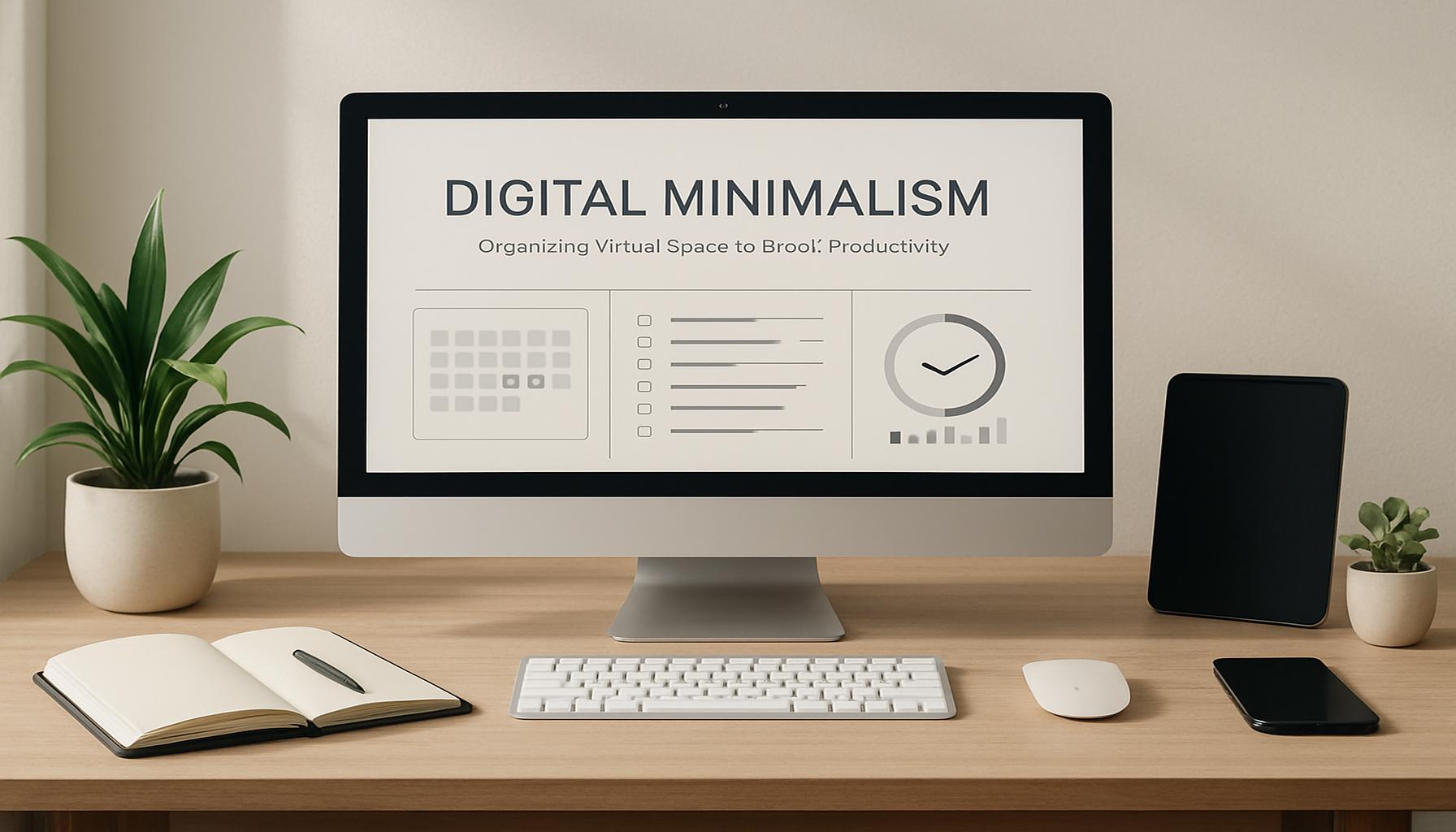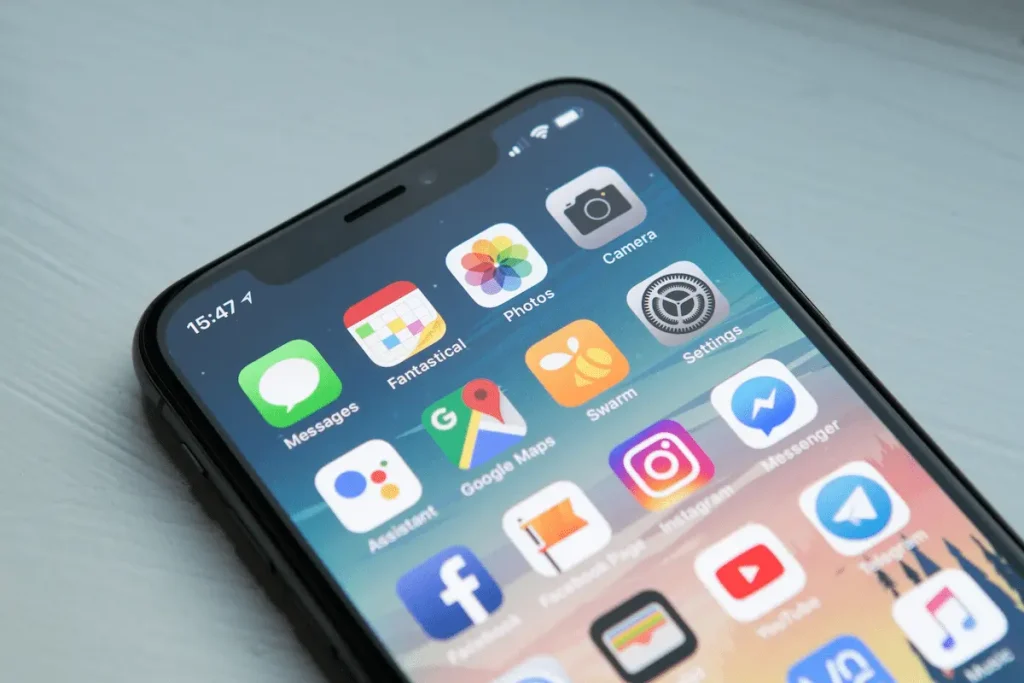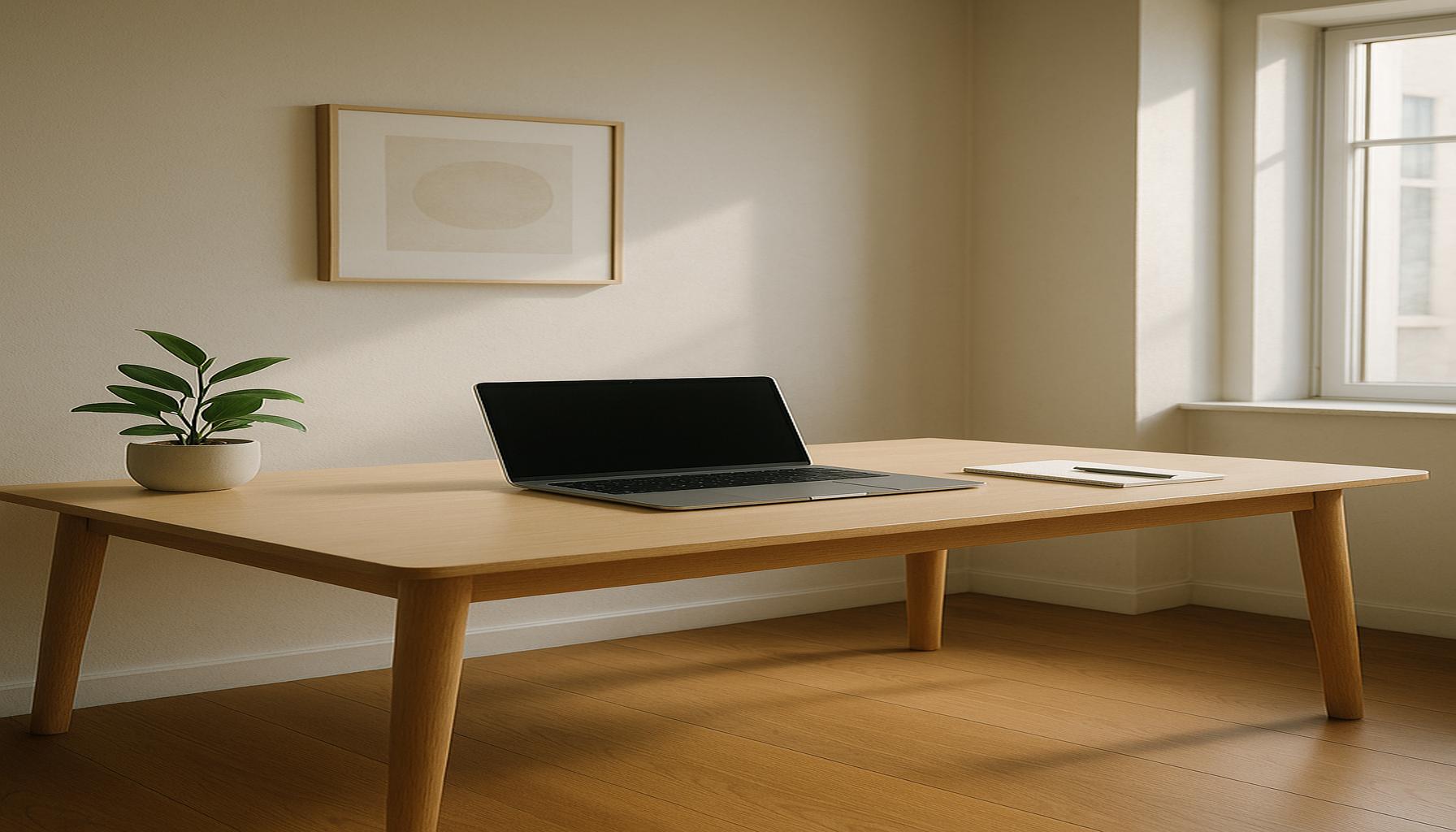Boost Productivity with Digital Minimalism Organize Your Virtual Space

Unlocking the Power of Digital Minimalism
In our hyper-connected world, the accumulation of digital clutter can stifle creativity and hinder productivity. Digital minimalism offers a solution, encouraging individuals to streamline their virtual spaces by focusing only on what truly matters. This practice not only enhances efficiency but also contributes to greater mental clarity and well-being.
The Relevance of Digital Cleanliness
As we increasingly rely on digital tools for both personal and professional tasks, maintaining an organized virtual environment has never been more critical. Consider these key benefits:
- Increased focus: Less distraction leads to better concentration.
- Time management: Efficient systems save valuable minutes throughout the day.
- Stress reduction: A tidy digital space fosters a sense of control and peace.
As you embark on your journey towards a cleaner digital presence, you’ll want to explore the top 5 tips that can revolutionize the way you interact with technology. Discovering these strategies can bring you one step closer to achieving a productive, minimalistic lifestyle.
Top 5: Digital Minimalism – Organizing Virtual Space to Increase Productivity
In the era of hyper-connectivity, where notifications never seem to cease and data flows incessantly through our screens, many individuals find themselves yearning for simplicity. The concept of digital minimalism steps into this chaotic narrative as a breath of fresh air, advocating for a selective and intentional relationship with technology. By reorganizing our virtual spaces and habits, we can not only reduce clutter but also harness our digital environment to amplify productivity and mental clarity. In this exploration, we delve into five essential strategies that have the power to transform a digital overload into a streamlined, efficient workspace.
5. Declutter Your Digital Workspace
Embarking on the journey of digital minimalism invariably begins with the act of decluttering. Imagine your digital workspace as your physical office: a cluttered space often leads to a cluttered mind. When your desktop is inundated with icons, your files are scattered across various unstructured folders, and your inbox is bursting at the seams, it’s easy to become overwhelmed.

- Desktop: Begin by tidying up your desktop. Each icon represents a looming task, a deferred decision. By limiting your desktop to a few essential shortcuts, you reduce visual stress and focus your attention.
- Files and Folders: Implement a consistent naming and filing system. For instance, categorize files by projects or dates, making it a breeze to locate documents without sifting through a pile of irrelevant data.
- Email Inbox: The average person receives over 120 emails per day. To manage this, adopt habits such as immediate deletion of spam, unsubscribing from unnecessary mailing lists, and using folders or tags to sort communications by priority or theme.
Decluttering establishes the foundational layer of digital minimalism, creating an inviting and efficient digital environment where you can work more productively. However, without further refinements, the clutter can gradually creep back in, so ongoing commitment is crucial.
4. Utilize Productivity Tools Wisely
The marketplace is replete with productivity tools promising to enhance efficiency, each vying for your attention. Yet, the paradox of choice can induce stress rather than simplify tasks. To achieve true digital minimalism, opt for a handful of reliable tools rather than an overwhelming array.
Consider honing in on a few key applications:
- Trello: Visualize and manage your projects with ease using boards, lists, and cards that reflect your unique workflow.
- Evernote: Collect ideas, notes, and inspirations in one centralized location, thus freeing your mind from the task of constant recollection.
- Todoist: Simplify and prioritize your tasks with an intuitive interface that keeps your to-do list organized and your time well-managed.
Diligently explore these tools’ features and integrations. Aim for simplicity and ease, allowing them to support your daily routines rather than complicate them. This disciplined approach ensures that each tool serves its purpose without becoming another digital distraction.
3. Implement Time-Blocking Techniques
A cornerstone of productivity, effective time management, finds supreme expression through time-blocking. This method, hailed by productivity experts, involves allocating distinct time slots for each activity, thereby structuring your day with deliberation.
To harness the power of time-blocking:
- Identify Task Types: Differentiate your tasks and responsibilities, such as meetings, emails, deep work, and leisure activities.
- Allocate Specific Time Slots: Designate specific blocks on your calendar for each task type, honoring these slots as you would an appointment.
- Limit Interruptions: During each time block, commit to the corresponding task, resisting the temptation to multitask or attend to unrelated tasks.
Through time-blocking, you cultivate a disciplined framework that enhances focus and nurtures deep work. The structured boundaries of your schedule empower you to make the most of each moment, resulting in tangible accomplishments and reduced stress.
2. Optimize Your Digital Tools for Focus
In a world where digital devices often dictate our lives, optimizing your tools can dramatically alter how you work. By tailoring settings to minimize distractions, your devices become allies rather than adversaries in your quest for productivity.
- Limit App Notifications: Notifications are designed to capture attention; curtail them by only enabling alerts from crucial apps to preserve your focus.
- Utilize Focus Modes: Engage “Do Not Disturb” modes during critical work phases, ensuring that your attention remains undisturbed.
- Adjust Digital Layouts: Organize your screen views to feature high-priority apps and functions prominently, streamlining your interaction with technology.
The outcome of these adjustments is a digital environment sculpted for productivity, where interruptions are minimized, and focus is enhanced. In this space, you can delve deeper into tasks and engage more meaningfully with your work.
1. Cultivate a Mindful Digital Routine
At the heart of digital minimalism lies the concept of mindfulness—a balanced digital routine that forms the pinnacle of this practice. It is not only about organizing your space but also about nurturing a reflective approach towards technology use.
Implement mindfulness in your digital life through these practices:
- Schedule Regular Breaks: Integrate breaks into your schedule to refresh your mind and mitigate digital fatigue.
- Assess Content Consumption: Evaluate and refine the content you engage with. Limit exposure to negative or unproductive media that can drain energy.
- Practice Digital Detox: Set aside regular periods where you disconnect from digital devices entirely to reconnect with the physical world and your inner self.
By embracing a mindful digital routine, you foster a harmonious relationship with technology. This routine not only boosts productivity but also enhances overall well-being, aligning your digital habits with your life goals. The essence of digital minimalism is a practice of intentionally choosing what to engage with and what to let go of—an endeavor that ultimately enriches both personal and professional spheres.
| Category | Key Features | Advantages | Disadvantages | Best Beneficiaries |
|---|---|---|---|---|
| Digital Decluttering | Systematic removal of unnecessary files and applications | Improved focus and efficiency when navigating digital spaces | Can be time-consuming if files are not organized regularly | Individuals overwhelmed by digital clutter |
| Structured Workspace | Creating organized folders and labels for files | Enhanced productivity through quick access to pertinent documents | Initial setup may require significant time investment | Professionals and students managing multiple projects |
| Streamlined Tools | Utilizing applications that integrate various tasks into one platform | Reduced context switching, leading to smoother workflow | Learning curve for new applications can disrupt existing routines | Teams and individuals looking for efficiency |
| Regular Maintenance | Routine checks for software updates and file management | Consistency in productivity is fostered with fewer disruptions from outdated tools | Requires commitment to a maintenance schedule | Long-term users of digital tools aiming for sustainability |
In exploring the philosophy of “Minimalismo Digital,” individuals are invited to consider the practical advantages that come with organizing their virtual spaces. For instance, **Digital Decluttering** involves systematically removing unnecessary files and applications, which can lead to an improved focus and efficiency while navigating digital environments. Although it may prove time-consuming, those overwhelmed by digital clutter can particularly benefit from this process.Another aspect that cannot be overlooked is the value of a **Structured Workspace**. This entails creating well-organized folders and labels for files, which ultimately enhances productivity by allowing for quick access to essential documents. While setting up this structure may involve an initial time investment, professionals and students managing multiple projects will find that the long-term benefits outweigh the upfront efforts.Moreover, utilizing **Streamlined Tools** serves to consolidate various tasks into one platform. This approach reduces the cognitive burden associated with context switching, therefore facilitating a smoother workflow. However, potential users must grapple with the learning curve associated with new applications, which may disrupt current routines. The advantages are often greater in the long run, particularly for teams or individuals seeking enhanced efficiency.Lastly, committing to **Regular Maintenance** of digital tools — from routine software updates to periodic file management — is crucial for fostering consistency in productivity. While maintaining a schedule may seem daunting, it ensures fewer disruptions from outdated technologies, appealing especially to long-term users aiming for sustainable digital practices.Through understanding and applying these aspects of Digital Minimalism, individuals are empowered to reclaim their focus and productivity in an increasingly cluttered virtual landscape.
Frequently Asked Questions about Digital Minimalism and Virtual Space Organization
What exactly is digital minimalism, and how can it improve my productivity?
Digital minimalism is a philosophy that emphasizes the intentional use of technology to enhance one’s quality of life. It involves reducing digital clutter and focusing on tools and applications that provide real value and aid in achieving personal and professional goals. By applying digital minimalism, you can experience increased focus, reduced stress, and better time management, leading to enhanced productivity.
How can I start implementing digital minimalism into my daily routine?
Initiating digital minimalism involves several steps, such as identifying and removing unnecessary apps and files from your devices, setting boundaries for screen time, and prioritizing tasks that align with your core values. Consider starting with a digital declutter session where you critically evaluate each digital tool’s relevance and optimize your virtual workspace for efficiency.
What are some common challenges people face when transitioning to digital minimalism?
Many individuals encounter challenges such as digital dependency and the fear of missing out (FOMO). Adjusting to a more minimal digital life may initially cause discomfort due to habitual technology use. Overcoming these challenges requires commitment to the process, gradual changes, and adopting mindful usage habits to maintain the balance between connectivity and disconnection.
Can digital minimalism coexist with modern technology demands?
Absolutely. Digital minimalism does not mean rejecting technology but rather advocating for a more mindful approach to its usage. Understanding which technological tools truly benefit you and learning to use them effectively aligns with modern demands. By implementing strategies like customizing notifications and using productivity apps wisely, you can maintain an optimal balance between technology use and minimalism.
Are there any resources or tools to help in practicing digital minimalism?
Numerous resources and tools can support your journey into digital minimalism. Books like “Digital Minimalism” by Cal Newport provide insights and strategies. Additionally, apps such as Freedom and StayFocusd help manage screen time, while Marie Kondo’s organizational methods can be adapted to virtual spaces. These resources can guide you toward a more streamlined and productive digital life.
Conclusion
In a world increasingly inundated with digital information and distractions, the principles of Digital Minimalism have never been more vital. The concept of organizing virtual spaces is not merely a trend but a necessary strategy for enhancing productivity and mental clarity. As we explored throughout the article, minimalism in our digital environments allows us to focus on what truly matters, reduces stress, and eliminates unnecessary clutter that can hinder our efficiency.
We highlighted key strategies to realize this transformation, starting with decluttering your digital devices. This involves deleting unused apps and files, organizing folders coherently, and setting boundaries on technology usage. Removing digital noise not only optimizes your computer’s performance but also helps in keeping your mind free from overwhelming choices and options.
The practice of applying minimalism to your daily digital interactions can significantly improve focus. By consciously choosing what to give attention to—be it emails, notifications, or social media—individuals can reclaim control over their time and concentration. Moreover, implementing productivity techniques such as the Pomodoro Technique within a minimalist framework makes it easier to maintain sustained efforts without fatigue.
In essence, adopting minimalism in our virtual spaces echoes the philosophy of simplifying life for well-being and productivity. While each individual’s needs and digital environments differ, the overarching concept remains innovative and impactful. As digital dependency continues to grow, the need to control and streamline these environments becomes imperative. Therefore, embracing digital minimalism can empower individuals to enhance their productivity and maintain a balanced relationship with technology.
Armed with these insights, readers are encouraged to explore further, evaluate their current digital habits, and consider the transformative power of minimalism for personal organization and productivity. The journey towards a digitally minimalistic lifestyle is not just a choice but a strategic approach to optimizing our modern lives.


